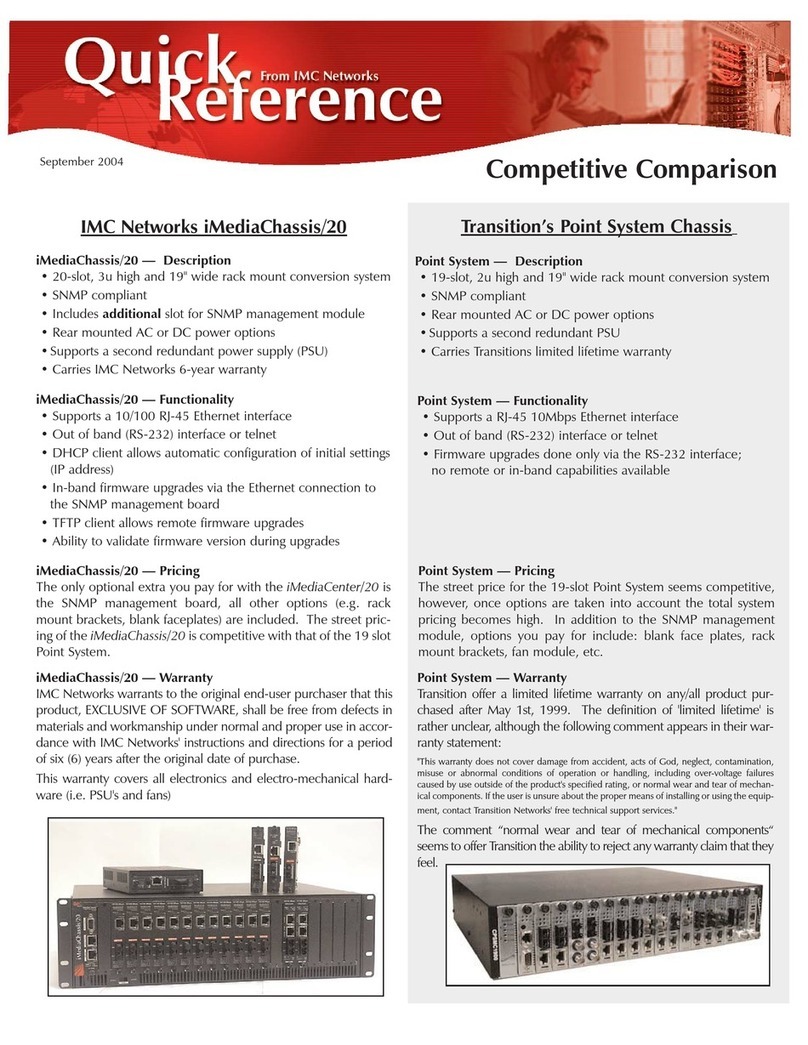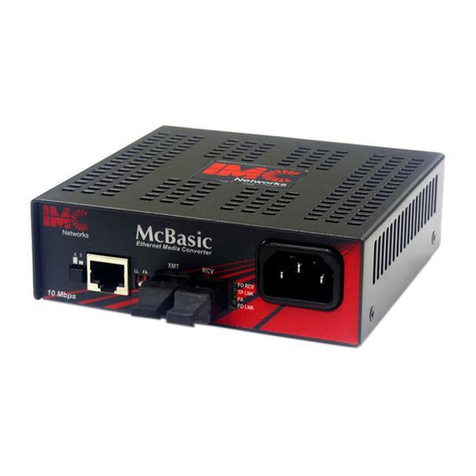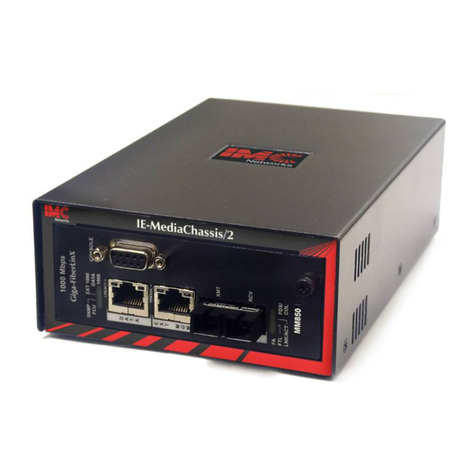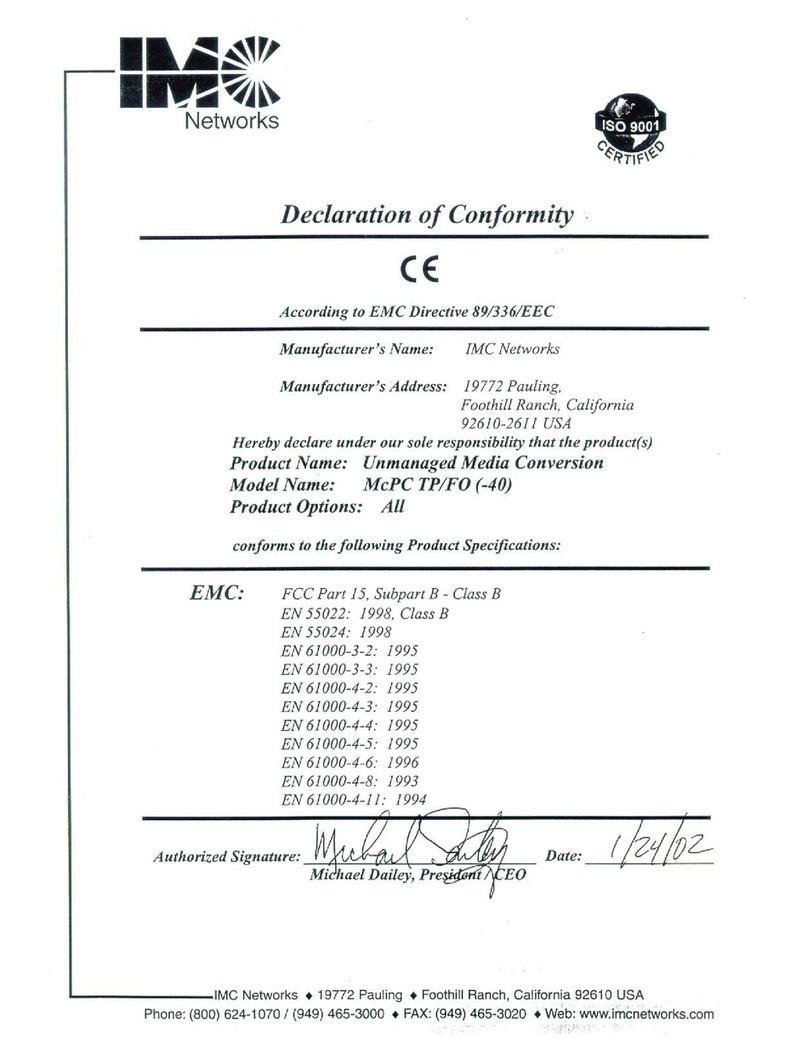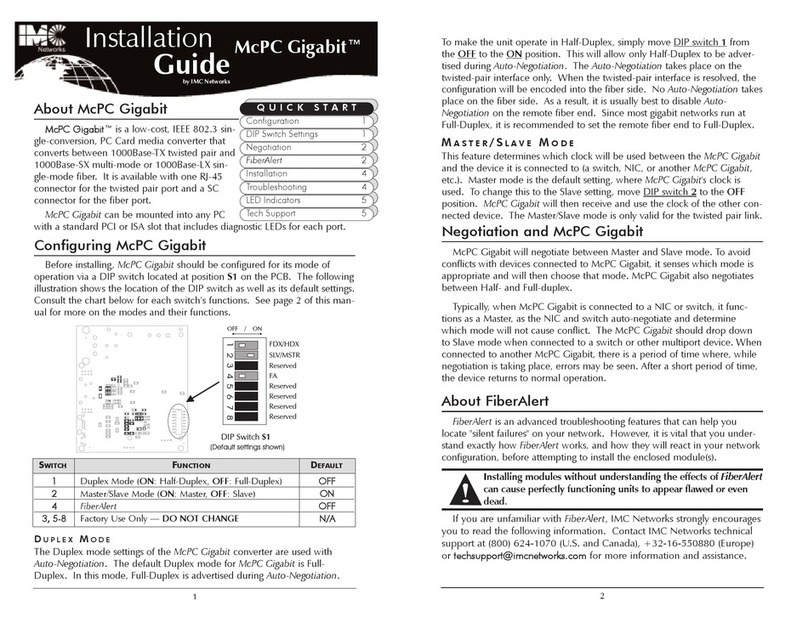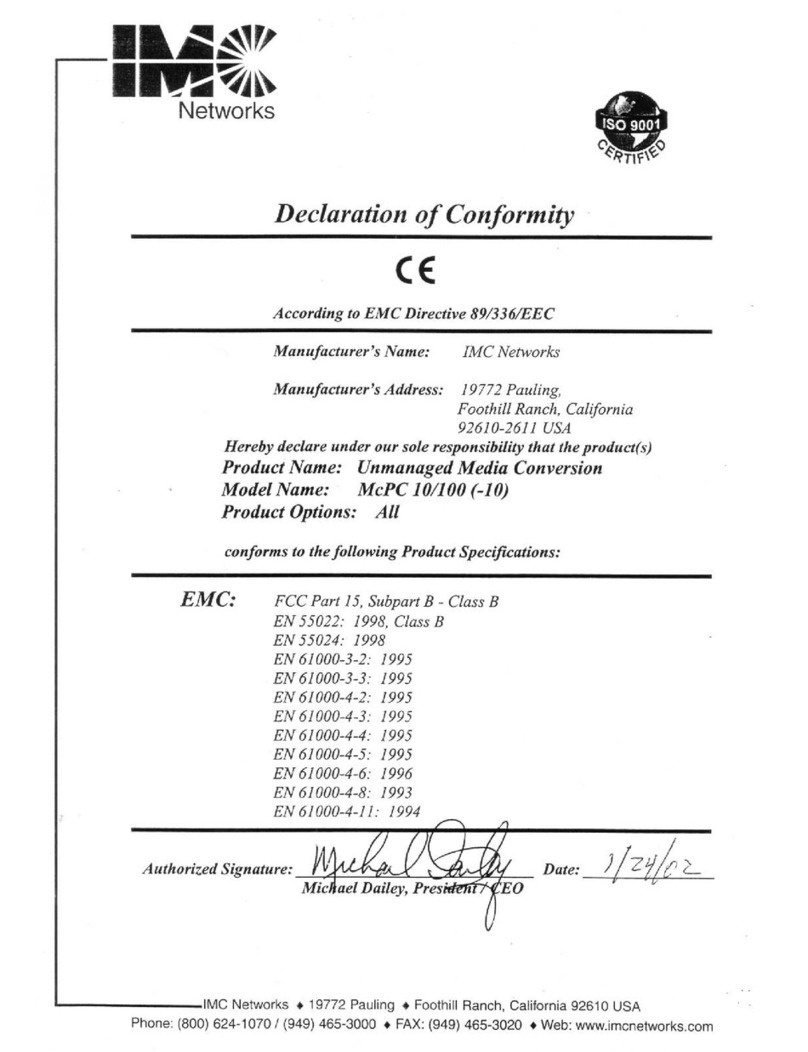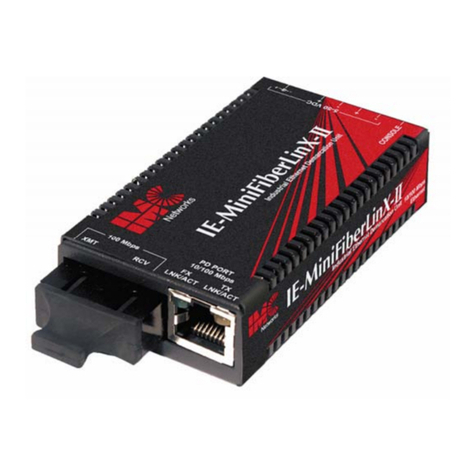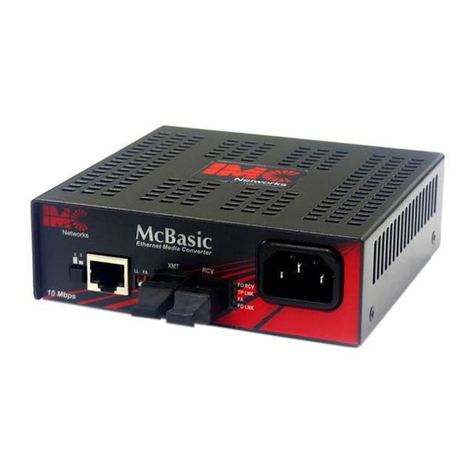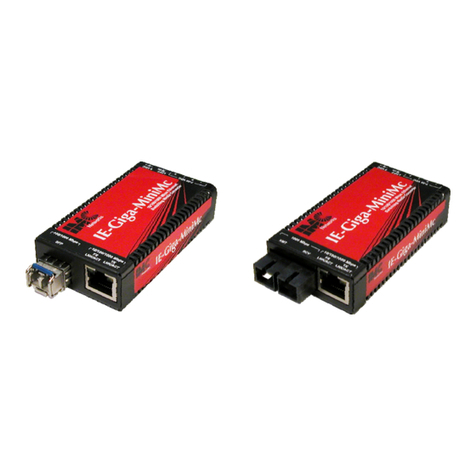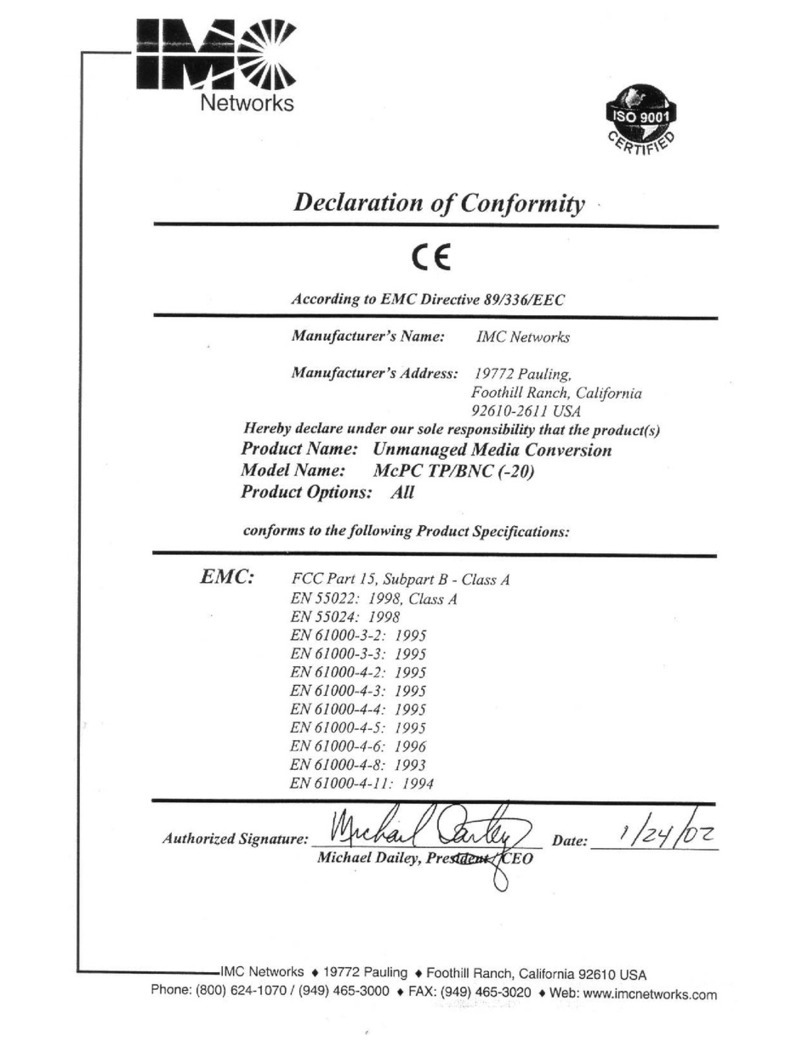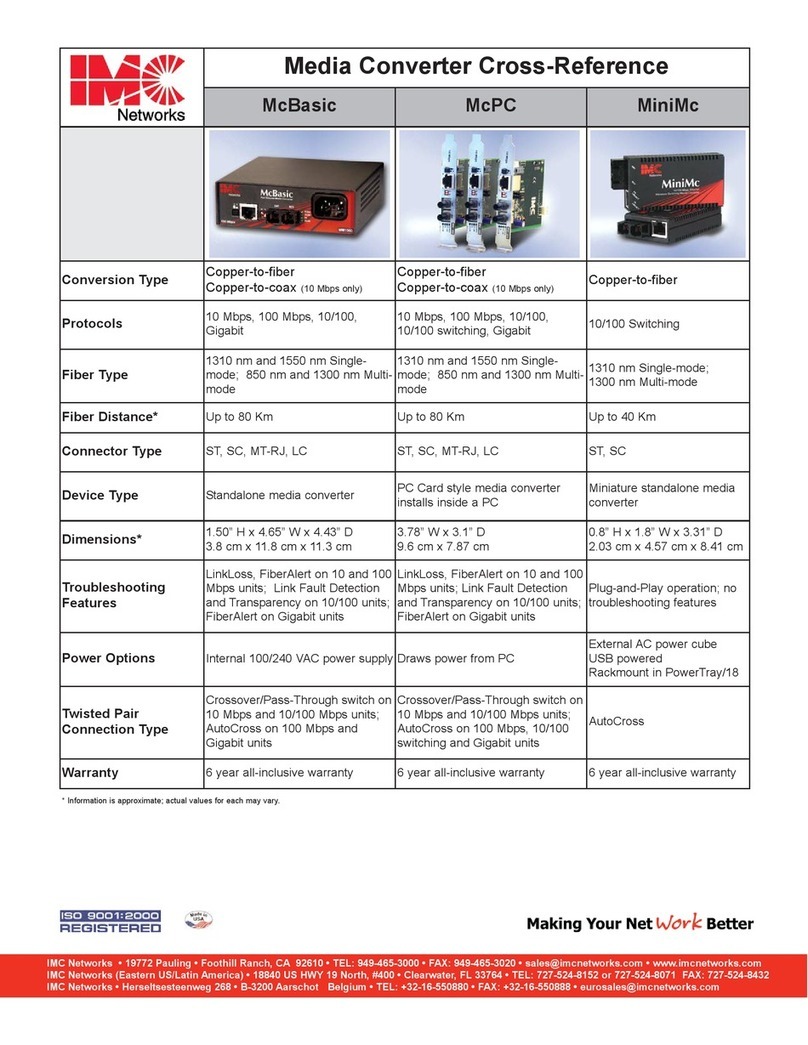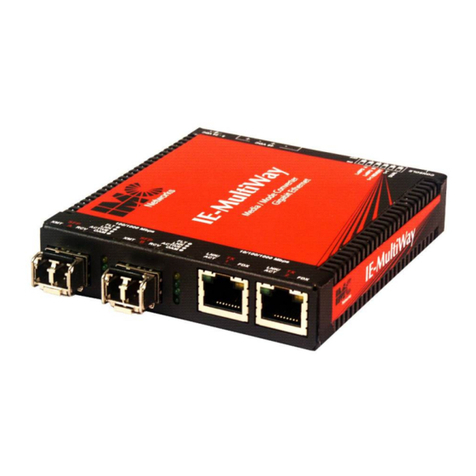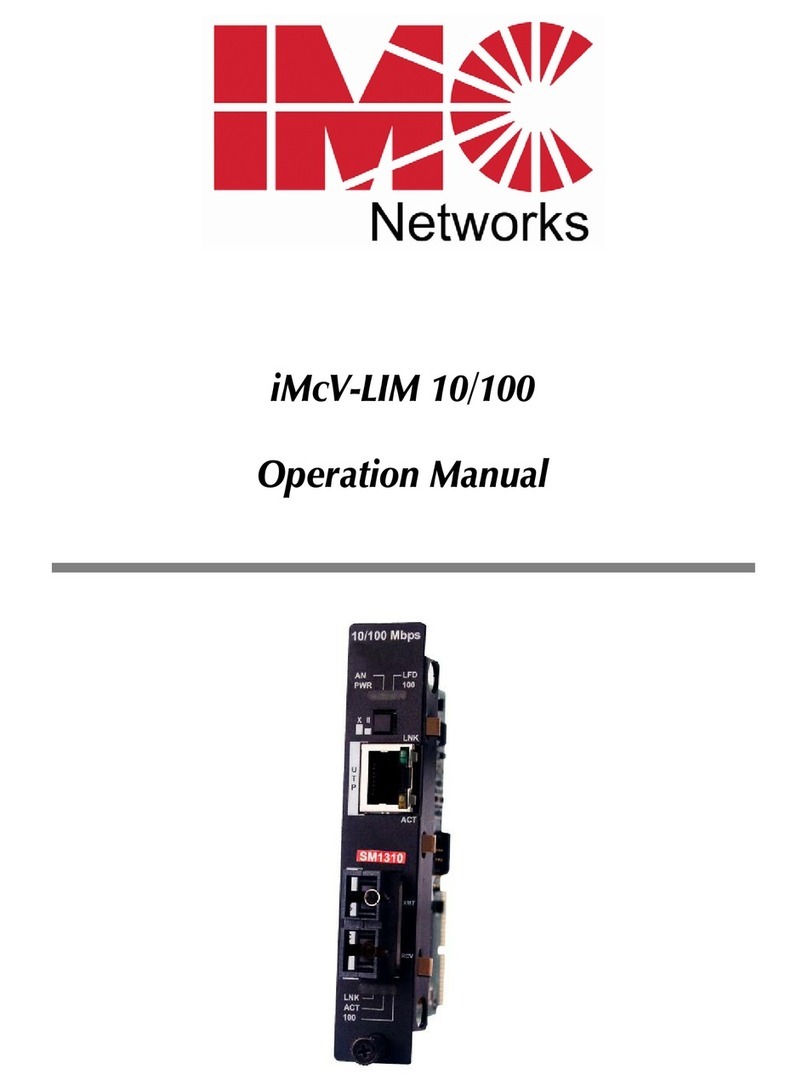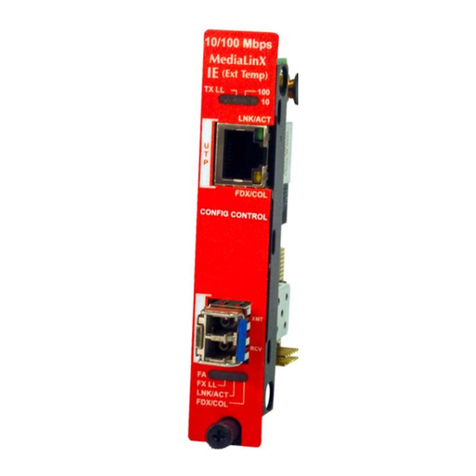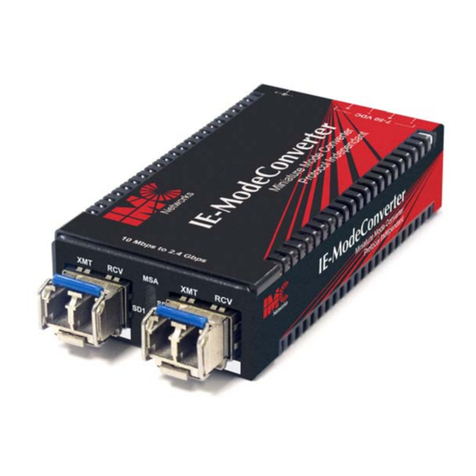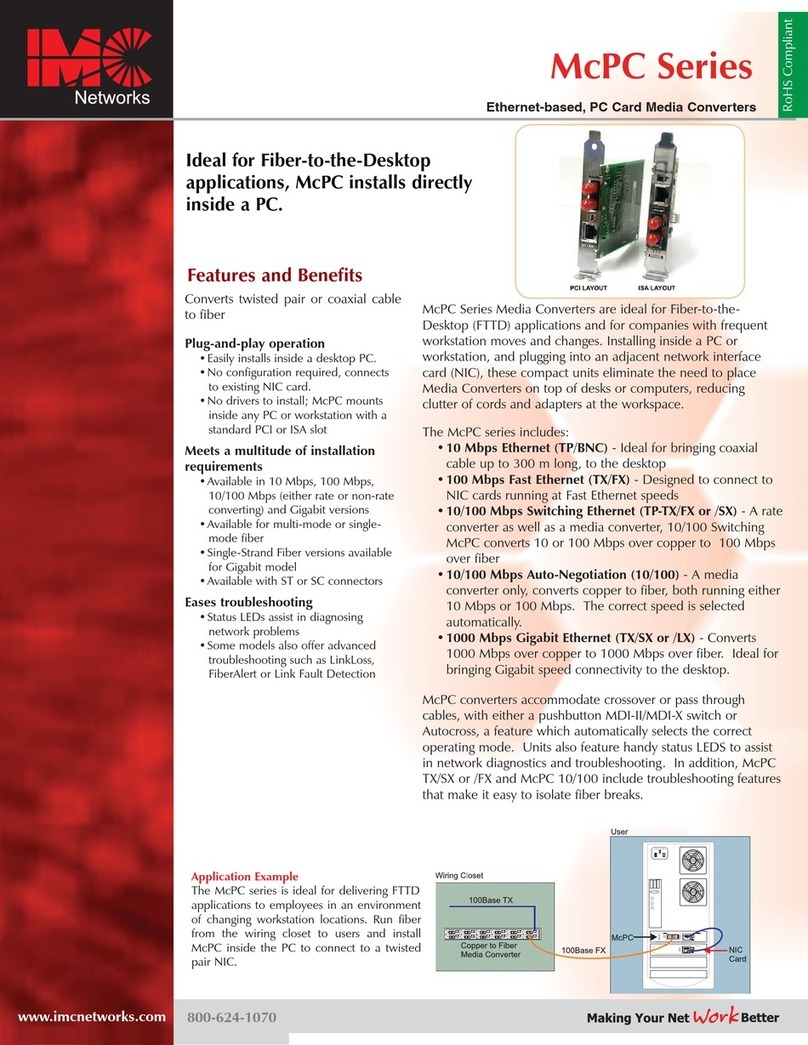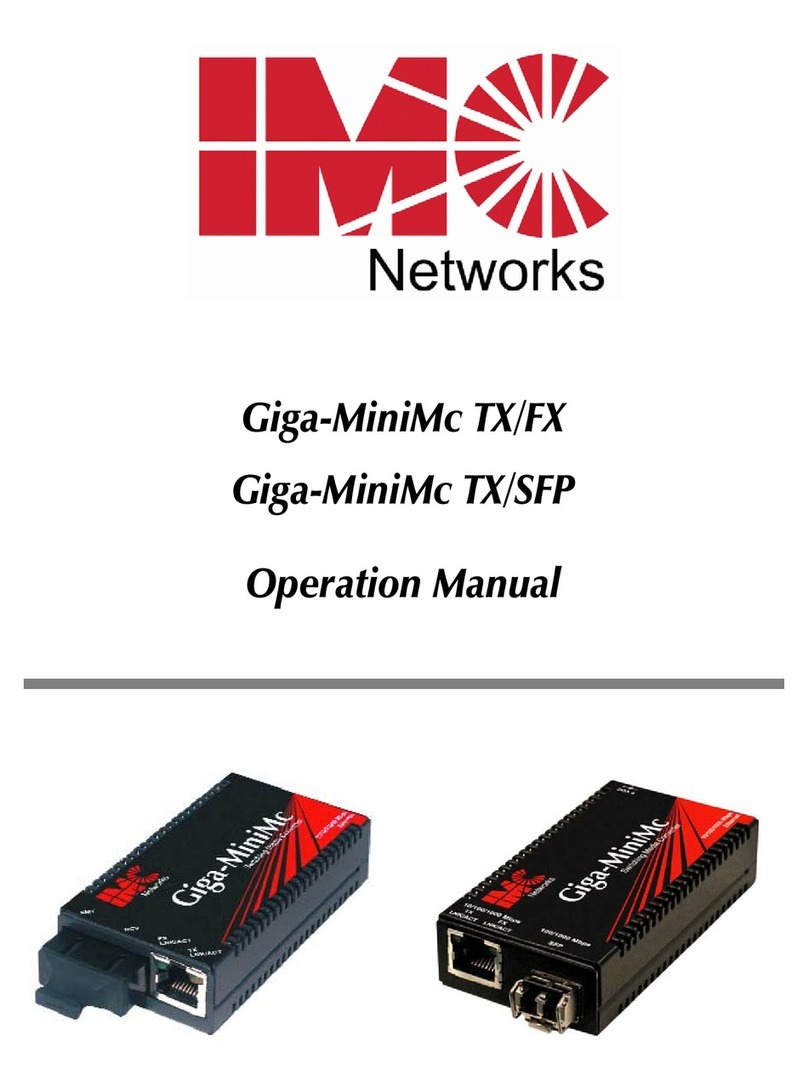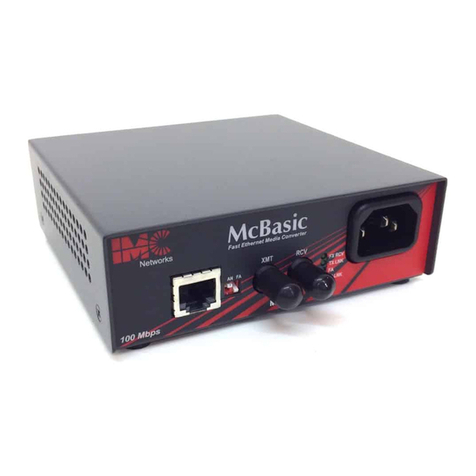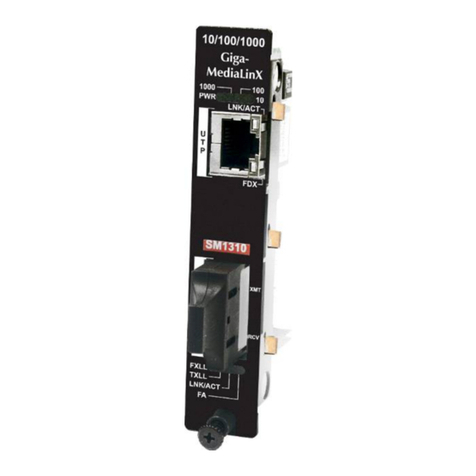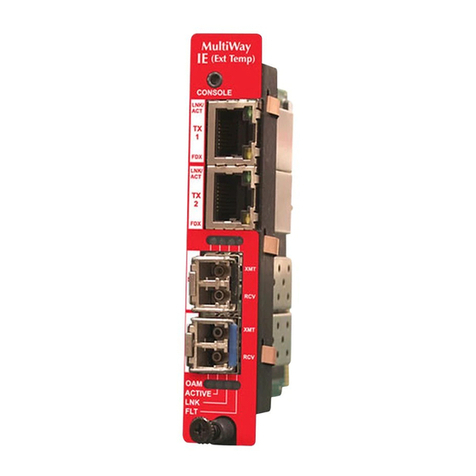SELECTIVE ADVERTISING WITH AUTO-NEGOTIATION
Selective Advertising, when used in combination with Auto-Negotiation, advertis-
es only the configured speed and duplex mode for the twisted pair port. If Selective
Advertising and Auto-Negotiation are both switched ON, the twisted pair port’s
speed (10 or 100 Mbps) and Duplex mode (FDX or HDX) can be separately config-
ured per your requirements. (See the Auto-Negotiation & Selective Advertising
Configuration Chart on page 2 for optional configurations using these features.)
If a specific speed and/or duplex mode is desired, it is recommended that you use Selective
Advertising rather than Force Mode, when connecting to devices that ONLY auto-negotiate
FORCING THE DUPLEX MODE
The twisted pair and fiber ports on iMcV-MediaLinX TX/SSFX modules can each be
manually configured for either Half- or Full-Duplex operation. Before manually set-
ting the duplex mode, Auto-Negotiation must be disabled. (Set Dip Switch 1 on S1
to the OFF position.)
• Configure the twisted pair port for Full-Duplex by setting Dip Switch 2
to the OFF position (Default).
• Configure the twisted pair port for Half-Duplex by setting Dip Switch 2 to
the ON position.
• Configure the fiber port for Full-Duplex by setting Dip Switch 6 to the
OFF position (Default).
• Configure the fiber port for Half-Duplex by setting Dip Switch 6 to the
ON position.
FORCING THE SPEED
The twisted pair port on iMcV-MediaLinX TX/SSFX can also be manually set for 10
Mbps or 100 Mbps operation. Before manually setting the speed, Auto-Negotiation
must be disabled. (Set Dip Switch 1 on S1 to the OFF position.)
• Configure the twisted pair port for 10 Mbps operation by setting
Dip Switch 3 to the OFF position.
• Configure the twisted pair port for 100 Mbps operation by setting
Dip Switch 3 to the ON position.
NOTE: The fiber port always operates at 100 Mbps.
Installing iMcV-MediaLinX, TX/SSFX Modules
iMcV-MediaLinX, TX/SSFX modules may be installed in any IMC Networks, iMcV
series or iMediaCenter series chassis. Each module will take one slot in the chassis.
To install a module, remove the blank brackets covering the slots (if present)
where the module is to be installed by removing the screws on the outside edges of
the bracket. Slide the module into the chassis, via the card guides, until the module
is seated securely in the connector. Secure the module to the chassis by tightening
the captive screw. Save any “blanks” removed during installation for future use
should your configuration requirements change.
Installation Troubleshooting
• During installation, first test your fiber and twisted pair connections with all
troubleshooting features disabled, then enable these features, if desired, just
before final installation. This will reduce the features’ interference with test-
ing.
• When working with units where the features cannot be disabled, you must
establish BOTH your twisted pair and fiber connections before the link LEDs
will light!
• To test the media converters by themselves, first make sure you have an
appropriate fiber patch cable, then follow these steps to test:
Step 1: Connect the media converter to the twisted pair device
with a twisted pair cable.
Step 2: Connect a single fiber cable from the local iMcV-MediaLinX TX/SSFX
module to a remote site iMcV-MediaLinX TX/SSFX module.
Note: iMcV-MediaLinX TX/SSFX modules function in pairs! Step 2 requires the use of
one iMcV-MediaLinX TX/SSFX (1310 XMT/1550 RCV)module at one end of the fiber
run, and an iMcV-MediaLinX TX/SSFX (1550 XMT/1310 RCV) module connected at the
other end of the fiber run.
Step 3: Verify that you have both twisted pair and fiber link (see LED on
following page) on your media converter.
• The fiber transmitters used on IMC Networks’ media conversion modules can
overdrive the receivers and cause data loss if used in installations where cable
power losses are low. To verify this, measure the optical power at the receiver.
The measured power should be no greater than specified and no less than the
Average Receive Sensitivity. For complete fiber specifications, visit our Web site
at: http://www.imcnetworks.com/adocs/fcs.asp
If measured power is greater than specified, install an optical attenuator to bring
power within specification. Contact IMC Networks for more information.
LED Operation
TWISTED PAIR LED
TX LL Glows green when TX LinkLoss is enabled.
100 Glows yellow when 100 Mbps is selected on port.
LNK/ACT
• Glows green when a link is established on port.
• Blinks green when data activity occurs.
FDX/COL
• Glows yellow when port is in Full-Duplex mode.
• Blinks yellow when modules are being operated in
Half-Duplex mode and collisions occur.
FIBER OPTIC LEDS
FX LL Glows green when FX LinkLoss is enabled.
LNK/ACT
• Glows green when a link is established on port.
• Blinks green when data activity occurs.
FDX/COL
• Glows yellow when port is in Full-Duplex mode.
• Blinks yellow when modules are being operated in
Half-Duplex mode and collisions occur.
General Information
IMC NETWORKS TECHNICAL SUPPORT
Phone: (949) 465-3000 or (800) 624-1070 (in the U.S. and Canada)
+32-16-550880 (Europe)
Fax: (949) 465-3020
Web: www .i mcne t w o r k s .com
WAARRRRAANNTTYYINNFFOORRMMAATTIIOONN
Please contact IMC Networks for complete warranty information.
456
SPECIFICATIONS
Environmental
Operating Temperature: 32° - 104° F (0° - 40° C)
Storage Temperature: 0° - 160° F (-20° - 70° C)
Humidity: 5 - 95% (non-condensing)
Power Consumption (Typical)
Input Load: 500mA
Fiber Optic Specifications
For fiber optic specifications, visit our Web site at:
http://www.imcnetworks.com/adocs/fcs.asp
FIBER OPTIC CLEANING GUIDELINES
Fiber optic transmitters and receivers are extremely susceptible to contamination by
particles of dirt or dust which can obstruct the optic path and cause performance degra-
dation. Good system performance requires clean optics and connector ferrules.
1) Use fiber patch cords (or connectors, if you terminate your own fiber) only from a
reputable supplier; low-quality components can cause many hard-to-diagnose prob-
lems in an installation.
2) Dust caps are are installed at IMC Networks to ensure factory-clean optical devices.
These protective caps should not be removed until the moment of connecting the
fiber cable to the device. Assure that the fiber is properly terminated, polished and
free of any dust or dirt and that the location is as free from dust and dirt as possible.
3) Store spare caps in a dust-free environment such as a sealed plastic bag or box so
that, when reinstalled, they do not introduce any contamination to the optics.
4) Should it be necessary to disconnect the fiber device, reinstall protective dustcaps.
5) If you suspect that the optics have been contaminated, alternate between blasting
with clean, dry, compressed air and flushing with methanol to remove dirt particles.
ELECTROSTATIC DISCHARGE PRECAUTIONS
Electrostatic discharge (ESD) can cause damage to your add-in modules. Always observe
the following precautions when installing or handling an add-in module or any board assem-
bly.
1) Do not remove unit from its protective packaging until you’re ready to install it.
2) Wear an ESD wrist grounding strap before handling any module or component. If
you do not have a wrist strap, maintain grounded contact with the system unit
throughout any procedure requiring ESD protection.
3) Hold boards by the edges only; do not touch the electronic components or gold
connectors.
4) After removal, always place the boards on a grounded, static-free surface, ESD pad
or in a proper ESD bag. Do not slide the board over any surface.
Questions or Comments about this manual? Contact tteecchhddooccss@@iimmccnneettwwoorrkkss..ccoomm
© 2002-2003 IMC Networks. All rights reserved.
The information in this document is subject to change without notice. IMC Networks assumes no responsibili-
ty for any errors that may appear in this document. iMcV-MMediaLinX, TX/SSFX is a trademark of IMC Networks.
Other brands or product names may be trademarks and are the property of their respective companies.
Document Number 56-80934-00-A4 March 2003
19772 Pauling • Foothill Ranch, CA 92610-2611 USA
TEL: (949) 465-3000 • FAX: (949) 465-3020
www.imcnetworks.com
WARNING! Integrated circuits and fiber optic components are extremely susceptible to electro-
static discharge damage. Do not handle these components directly unless you are a qualified
service technician and use tools and techniques that conform to accepted industry practices.
